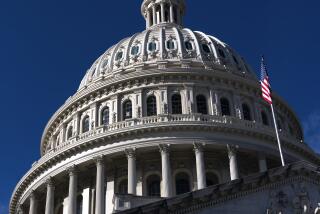After years of declining numbers, veterans in Senate may gain a seat
The number of military veterans in the U.S. Senate had declined in every election since 1982 — until Tuesday.
Victories by three newcomers — Republicans Tom Cotton in Arkansas and Joni Ernst in Iowa and Democrat Gary Peters in Michigan — guarantee that the total will remain at least at 20. Going into the midterm election, 20 senators had served in the armed forces. Three whose terms are expiring chose not to run.
The number of vets in the Senate will rise to 21 if Republican Dan Sullivan wins in Alaska, where he leads the incumbent by 3.7%, or 8,149 votes, with tens of thousands of absentee ballots yet to be counted.
Cotton, Ernst and Sullivan all served in the recent wars.
Seth Lynn, who heads Veterans Campaign, a nonprofit group in Washington that trains former service members to run for office, said he was celebrating. “The expectation was that the number would drop,” he said.
The number of veterans in Congress has fallen dramatically over the last three decades. Their representation in the Senate peaked at 73 out of 100 in 1983. The number in the House topped out at 347 — or 80% — in 1977. Today, the number is about 20% in each chamber.
The decrease mirrors a large decline in the U.S. veteran population, which fell from 28.5 million in 1980 to 26.4 million in 2000 and to 22 million today. The government projects it will fall to 17.4 million by 2030.
Tuesday’s results did not stem the decline in the House. There were 86 veterans in the House going into the election, according to Lynn.
Two of those lost in the primaries, eight retired and four ran for a different office, according to Lynn. Two more lost on Tuesday.
The new tally will be 81 to 84, depending on the results in three races still too close to call. If those three veterans — Jeff Gorell and Paul Chabot of California and Martha McSally of Arizona — squeak out victories, the next freshman class will include 14 newly elected veterans. Gorell, Chabot and McSally, all Republicans, seved in Iraq or Afghanistan.
In a postelection analysis, Lynn noted that veterans of the recent wars were playing a growing role in Washington politics. There will be at least 20 in the House when the next session begins.
Democrats Tammy Duckworth of Illinois and Tulsi Gabbard of Hawaii — who in 2012 became the first female veterans of the recent wars to be elected to Congress — both easily won reelection. Only three female veterans had been in Congress before them. Ernst is the first elected to the Senate.
It is difficult to measure the impact of veteran status on election results. Incumbency and party affiliation are much stronger factors, according to Jeremy Teigen, a political scientist at Ramapo College in New Jersey.
Indeed, those factors seemed to prevail Tuesday. More than 80% of veterans running against incumbents lost, Lynn found.
The newly elected veterans rode the Republican wave that resulted in the party’s takeover of the Senate and expanded majority in the House.
Just four of the newly elected veterans in the House and one in the Senate are Democrats.
Nearly three-quarters of the veterans in both chambers combined are Republicans.
More to Read
Start your day right
Sign up for Essential California for news, features and recommendations from the L.A. Times and beyond in your inbox six days a week.
You may occasionally receive promotional content from the Los Angeles Times.






